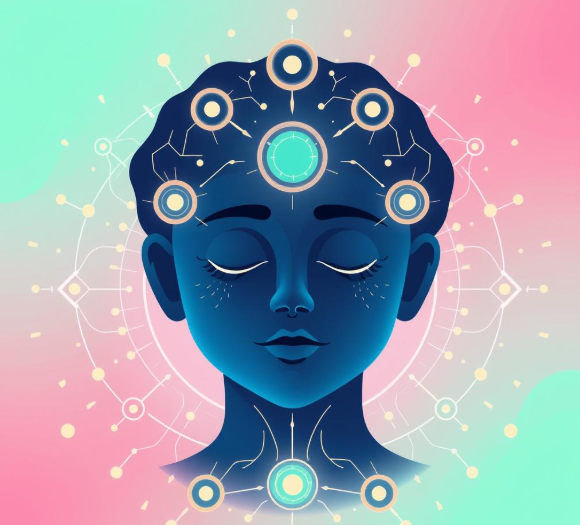Mindful Algorithms & Emotional AI: How Technology Is Reshaping Emotional Wellness and Spiritual Life 🤖🧘♂️

In today’s era when everything is running with the help of algorithms and automation, a deep question arises – can Artificial Intelligence really understand human emotions? Is it just calculation, or is there a little compassion in it too? This question becomes even more personal when we talk about our mental well-being and spiritual growth.
Today, emotional AI and mindfulness-based technology are not a dream of some distance but have become a part of our daily life. Mood-tracking apps, AI journaling companions, sentiment analysis tools — these are no longer just gadgets, but digital companions that try to connect with us. Perhaps for the first time, technology is not just distracting us, but helping us listen to our inner voices.
In this blog, we will explore what the emotional AI landscape looks like today — how it is integrating into wellness platforms, and whether it can truly become a support system in our emotional journey. Can these mindful algorithms “feel” our emotions, or do they just create an illusion of care based on data? Let’s dive deeper and find out — from the heart.
1. The Rise of Emotional AI 📈🤔
Emotional AI does not mean just smart technology, but digital thinking that tries to feel human emotions. These are such machines that start understanding your state of mind just by your tone of voice, a slight smile on your face, the way you write your words, or even the speed of your breathing. Big names like Affectiva, Replica and Microsoft are developing tools that are capable of catching every small emotional nuance – without you even saying anything.
Initially, this technology was more limited to customer support or mental health assessments – like a smarter version of a chatbot. But now Emotional AI is moving in a new direction. Now its focus is not just on solving problems, but also on connecting with the human mind and soul. For the first time, technology is not just ready to give answers, but to really listen.
2. Mood-Tracking Apps: A New Emotional Mirror 📱🪞
One of the most accessible uses of Emotional AI is mood-tracking. Apps like Daylio, Moodfit, and Youper help users understand their emotional patterns through AI insights and daily prompts. Some of these apps have features that suggest mindfulness exercises, journal prompts, or guided meditations based on your mood.
For example:
🔹 Youper uses conversational AI to have reflective dialogue with users and suggest CBT (Cognitive Behavioral Therapy) based responses.
🔹 Wysa combines AI chat with emotional coaching, where users can share their problems and get empathetic responses from a non-judgmental bot.
These apps don’t feel emotions themselves, but they provide a safe space where people can explore their emotions — especially for those who feel hesitant to talk to a human being.
3. The Science Behind Sentiment Analysis 🧠🔍
Sentiment analysis is a digital technique that tries to understand the feelings hidden behind words. Using Natural Language Processing (NLP), this system judges whether a message is positive, negative, or just neutral. Earlier, it was mostly used to track social media reactions or customer reviews — but now its role is rapidly growing in mental wellness as well.
Like in apps like Replika, AI doesn’t just read the words you write — it also picks up signals of slight changes in your tone, pauses, and mood. Sometimes there is just a hint of sadness, and the AI sends you a gentle, empathetic message – like a dear friend who is just listening without judging. Many platforms use this technology to track the emotional trends of their users – and when a user is in a crisis state, they alert human moderators so that timely help can be provided.
Yes, these systems do not yet “feel” like humans – but the amount of care they show after understanding the context, it feels real and comforting for many people. As if technology has not just become intelligent, it has also become a little sensitive.
4. AI Empathy Tools in Mindfulness Platforms 🧘♀️📊

Today’s mindfulness platforms are not just meditation apps — they have become digital companions that try to understand your mood, stress, and behavior. Apps like Headspace, Insight Timer, and Calm are now using Artificial Intelligence to make each user’s experience even more personal and meaningful.
🔹 Platforms like Insight Timer look at your previous meditation sessions, stress levels, and sleep patterns and suggest the session that may be most healing for you at that moment.
🔹 Headspace has tested a version of AI that subtly adjusts the tone and duration of meditations by understanding your engagement patterns — like a real teacher speaking to you according to your mood.
In addition, new-age wellness startups like MindFi and InnerHour are also using emotion-sensing algorithms. Their aim is simple — to create a mental health journey for every user that is not generic, but truly personal. Not like an app, but a digital companion that moves along with your emotional rhythm.
5. Can AI Actually Empathize? 🧑💻❤️
One thing we all need to understand – AI does not feel. It has no heart, no emotional depth. It operates only on data and algorithms. But still, it can be designed in such a way that it seems empathetic – and sometimes, its response is so natural that we feel as if it is really understanding us.
When a user feels a little lightheaded after talking to an AI chatbot, there is a psychological effect called the Eliza effect – named after an old AI therapist simulation. This means: when machines talk human-like, humans start treating them as humans too. Maybe that’s why we share personal things with them – as if they are really listening to us.
So yes, technically AI doesn’t feel emotions. But when the illusion of care seems so real that someone can open his heart, maybe that illusion also has a healing value. Sometimes, just getting a non-judgmental space is enough – whether the person in front is a human or a machine.
6. Benefits of Emotional AI in Spiritual and Emotional Well-being 🌿🕊️
Despite its limitations, Emotional AI brings some unique gifts that have become valuable to many people today:
🔹 Always with you – 24×7:
AI has no weekends, no lunch breaks. Whether you feel like talking to someone at 2 in the night or have any heavy emotion as soon as you wake up in the morning – AI-based companions are always available, without delay.
🔹 Judge-Free Zone:
Many people cannot feel vulnerable in front of a human therapist, but when there is a machine in front of them – their heart opens up. There is no observation, only a listening system. People say, “At least it does not judge.”
🔹 Understanding your emotional pattern:
AI tools quietly observe your mood swings, daily patterns, and emotional triggers over time — without interrupting. And then they give you insights that help you understand yourself.
🔹 Accessible for every pocket:
Mental health support can be expensive in many places. But emotional AI tools — like journaling apps, chatbots, or mood trackers — are mostly free or low-cost. For this reason, today mental wellness is not just a privilege but is becoming everyone’s right.
7. Real-World Examples 🌐💬
🌐 Replika
Replika is an AI chatbot — but calling it just a chatbot would probably mean diminishing its role. As you talk to it, it learns from you, and slowly becomes a digital friend, sometimes a life coach. Many people openly share their emotions with it, without any hesitation. Replika doesn’t just listen to you — it also gently guides you towards self-awareness and mindfulness.
💬 Woebot
Woebot is a little different — it was created by clinical psychologists. It delivers scientifically proven therapy techniques through AI in a friendly conversation format. As you type your thoughts, Woebot identifies negative patterns or cognitive distortions and reframes them in a soft and supportive way — like a therapist listening to your heart.
🧘♀️ Innerworld
Innerworld is a VR-based mental wellness space — where you not only meditate, but also become part of an immersive spiritual journey. Here AI and real community members come together to create a safe space where you can explore your thoughts, emotions and fears — without any judgment. Amidst nature sounds, calming visuals, and guided reflections, you feel as if you are sitting in your inner temple and talking to peace.
8. Where Emotional AI Falls Short 🚫🤷♂️
While emotional AI is becoming a silent companion for many people, there are some important limitations too — which we should keep in mind:
🔸 Understanding everything is not easy:
AI is smart for sure, but it still fails to understand complex layers like sarcasm, cultural nuances, and deeply personal emotions. Sometimes it gives literal answers, when we only need empathy.
🔸 Lack of depth:
When it comes to existential dilemmas, spiritual questioning or inner conflicts, AI’s understanding is still superficial. The way a human feels and answers — that depth has not yet come to the machine.
🔸 Too much trust can also be risky:
Sometimes we feel so comfortable with AI that we get distanced from real conversations. But sometimes those tough talks, live reactions, and human perspective are also necessary for emotional growth – which only a living, breathing human can provide.
So yes, Emotional AI can be a beautiful companion – but it is not a replacement for humans, it is a supplement. Sometimes technology only shows us a path – we have to walk on our own.
9. Future Trends in Emotional AI 🔮📱
When we look at Emotional AI today, it feels like we’re just at the beginning. In the coming years, the relationship between technology and the heart will deepen — and it will become a truly heart-centered experience, not just data analysis. Some inspiring trends that are shaping this future:
🧠 Emotionally Intelligent Wearables
Imagine a wearable that can read your mood through your voice tone, facial expressions, and even heartbeat — and give you a soft reminder without saying anything: “Take a deep breath.”
🕶️ VR Therapy Rooms
Immersive therapy rooms where you are in a calm forest or sacred temple through your digital avatar — and an AI guide gently leads your healing journey, without judgment.
🤖 Sentient Avatars
The bots of the future won’t be just script-following assistants — they will have distinct personalities. They will behave based on your mood, behavior, and past conversations just like a real, understanding friend would.
👓 Emotion-Sensing AR Glasses
You’re talking to someone, and your glasses detect subtle emotional cues to help you connect better. Like a quiet emotional coach, just beside you.
The core purpose of all these innovations is not just to track emotions – but to take us in a direction where we live a more aware, connected, and emotionally conscious life.
10. Final Reflection: Can Algorithms Really Be Mindful? 🧘♂️💭
The concept of “mindful algorithms” may sound a little contradictory, since mindfulness involves awareness, being in the present moment, and non-judgment — all of which are deeply connected to the human experience.
But if AI is ethically designed and put to intentional use, it can remind us to pause, reflect, and reconnect with ourselves.
Whether it’s a chatbot asking you how your day went or a mood tracker noticing when you’re feeling low, these technologies act like a digital mirror.
This does not reflect your soul – but it can definitely help you reach it.
📩 Stay Connected!
Want more such hacks, productivity, and mindful tech tips?
👉 Subscribe to our newsletter at SoulWithMindTech and never miss an update.
🔗 YouTube – SoulWithMindTech Channel
📸 Instagram – @soulwithmindtech
📘 Facebook – SoulWithMindTech Page
🌐 Website – www.soulwithmindtech.com
